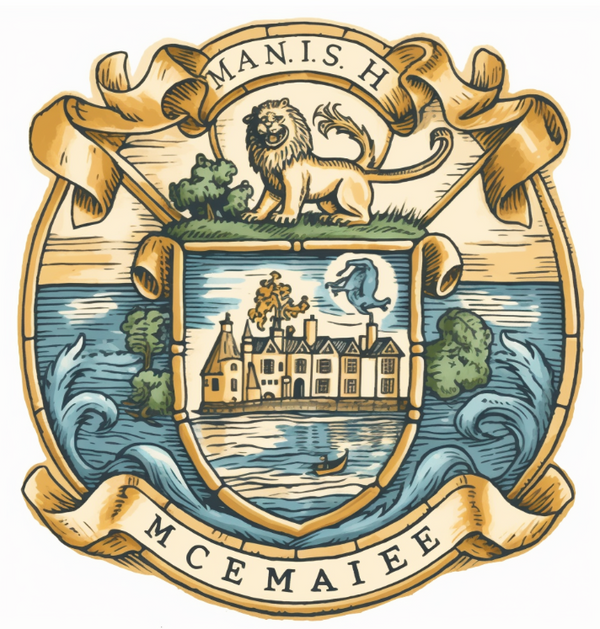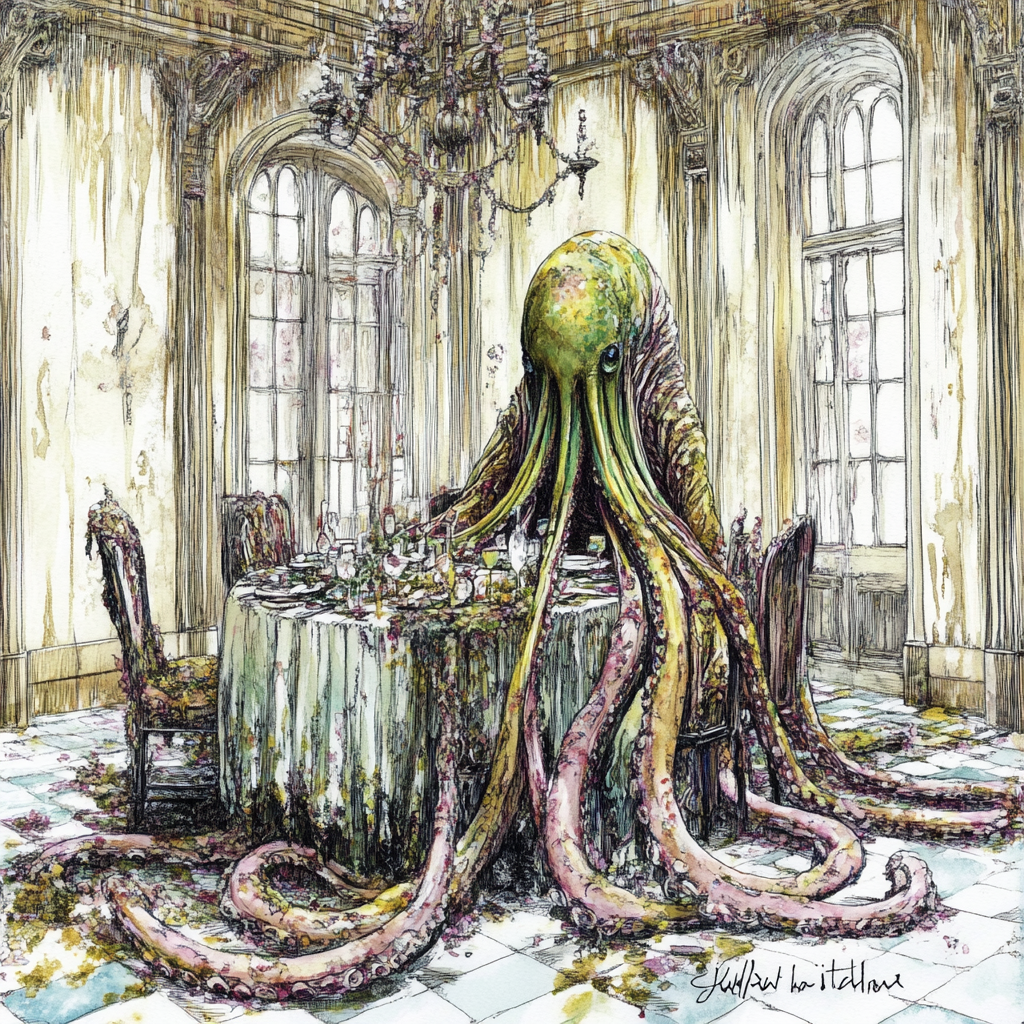All images – are available for sale on utterwickmuseum.com - we have an amazing search facility and thousands of weird things in our museum - all can be purchased for but a few pennies and a print will be created and sent to your threshold.

Step into the mesmerising world of gothic horror creatures and famous monsters, where art and imagination blend in a haunting dance of beauty and terror. As the unconventional curator of the Utterwick-on-the-Marsh Museum of Arts and Antiquities, I am delighted to unveil the dark charms of gothic ruins and the eerie tales whispered by these otherworldly entities. Against a backdrop of crumbling castles and misty marshes, we will explore the profound symbolism these gothic creatures and monsters encapsulate, reflecting our innermost fears and desires. So, take up your lantern and accompany me into this captivating realm, where every brushstroke and stone narrates a story of love, loss, and the eternal battle between light and shadow.
Enchanting Gothic Aesthetics
Whispers of Gothic Ruins

Gothic ruins stand as silent witnesses to time's relentless progression, with each crumbling stone and vine-draped archway narrating a tale of bygone grandeur. These decaying structures, often shrouded in mist and shadow, evoke a powerful sense of melancholy and mystery. As we amble through these abandoned castles and forgotten abbeys, the weight of history seems to bear down upon us. The beauty of these gothic ruins lies not only in their architectural grandeur but also in the emotions they stir within. They poignantly remind us of impermanence and the relentless march of time. In art, these ruins often symbolize the inner turmoil of the human soul, reflecting our fragility and the transient nature of existence. Let us heed the whispers of these ancient stones, for they have much to reveal about our own haunted hearts.
Symbolism in Gothic Creatures
Gothic creatures, with their haunting forms and enigmatic presence, transcend simple gothic horror. Each embodies profound symbolism, tapping into the recesses of our psyche. Vampires, for example, represent forbidden desires and the fear of eternal damnation, reflecting our struggle with morality and temptation. Werewolves, trapped in duality, symbolize the battle between our civilized selves and our primal instincts. Meanwhile, specters and ghosts hover on the fringes of the living world, serving as reminders of unresolved grief and the inescapable nature of death. As we encounter these gothic monsters in art and literature, we are invited to confront our own fears and fantasies. They challenge us to ponder the complexities of human nature and the lurking darkness within. By embracing these gothic creatures, we gain insight into our deepest fears and desires, transforming the grotesque into something eerily beautiful.
Famous Gothic Monsters

Classic Icons Reimagined
In the realm of gothic horror, classic icons like Dracula, Frankenstein's monster, and the Headless Horseman have been reimagined countless times, with each iteration offering a fresh perspective on familiar tales. These enduring gothic monsters captivate us not only through their sinister allure but also through their capacity for reinvention. Artists and writers breathe new life into these figures, exploring themes resonant with contemporary audiences. Dracula, for instance, may evolve from a feared predator into a tragic anti-hero, highlighting themes of loneliness and redemption. Frankenstein's monster might transform into a symbol of technological hubris in our modern age. This perpetual reimagining keeps these gothic creatures relevant, allowing them to speak to each generation's fears and aspirations. By revisiting these icons, we uncover layers of meaning within their stories. This process of reimagining lets us explore the shifting boundaries between humanity and monstrosity, light and darkness.
Lesser-Known Haunting Figures
Beyond the well-traveled corridors of famous gothic monsters, lesser-known figures haunt the fringes of gothic lore. These enigmatic creatures and spirits enrich the tapestry of gothic horror with their unique stories and symbolism. Consider the Banshee, whose mournful wails foretell death and serve as a reminder of our mortality. Or the Wendigo, a creature birthed from tales of insatiable hunger and moral decay, challenging us to confront the dark corners of human desire. Another intriguing figure is the Golem, an entity crafted from clay, symbolizing the power and peril of creation. These lesser-known gothic creatures offer fresh narratives and unexplored themes, inviting us to delve deeper into the shadows. By casting light on these obscure figures, we enhance our understanding of the gothic and uncover new avenues for reflection and inspiration within these eerie realms.
Light and Dark in Gothic Art
Emotional Resonance in Paintings

In gothic art, the interplay of light and dark is crucial, crafting emotional resonance that captivates and moves the viewer. Artists skillfully employ chiaroscuro—the contrast of light and shadow—to evoke mystery and tension. This technique draws attention to the painting's focal points, highlighting the drama and turmoil within. Consider the ethereal glow of moonlight casting eerie shadows in a haunted landscape, or the flicker of candlelight illuminating a solitary figure in contemplation. These light sources do more than merely brighten; they reveal the psychological depths of the subjects. The stark contrasts amplify themes of inner conflict, unrequited love, and existential dread. In exploring these paintings, we confront the duality of our own nature, where light and darkness coexist. This emotional depth transforms gothic art into a powerful medium, leaving a lasting impression on those who dare to gaze upon it.

Architecture as a Storyteller
In gothic art, architecture transcends mere background, becoming a vital storyteller in its own right. With their towering spires, intricate tracery, and shadowy corridors, gothic structures convey narratives rich with symbolism and emotion. Each architectural element, from pointed arches to flying buttresses, reflects an underlying tension between the ethereal and the earthly. Crumbling facades and dilapidated towers speak of past grandeur and present decay, mirroring the inner turmoil of the characters within. The interplay of light through stained glass windows casts a kaleidoscope of colors, adding layers of meaning to the scenes they illuminate. These architectural features serve not only as visual spectacles but also as metaphors for the human condition—echoing themes of isolation, aspiration, and the passage of time. Through these stone edifices, artists weave a narrative tapestry that invites exploration into the depths of gothic storytelling.
Gothic Creatures in Mythology

Vampires
Vampires are immortal beings that sustain themselves on the blood of the living. Originating in Eastern European folklore, these creatures embody themes of desire and the fear of the unknown. They have evolved as symbols of forbidden and eternal passion, forever intertwining love with death.

Werewolves
Emerging from European folklore, werewolves are humans cursed to transform into wolves under the full moon. This duality represents the struggle between our civilized selves and primal instincts, highlighting the battle between control and the wild, untamed nature within us all.

Banshees
In Irish myth, a Banshee is a spirit whose haunting wail foretells the death of a family member. This ethereal being personifies grief and the inevitability of mortality, reminding us that life is a fragile thread.
Wendigo
Rooted in Algonquin folklore, the Wendigo represents insatiable hunger and moral decay. This creature, said to roam the forests of the North, challenges humanity to confront its innate greed and fear of losing control to darker impulses.
Golems
Stemming from Jewish folklore, Golems are beings made from clay or mud, brought to life through mystical rituals. They symbolize the power and responsibility of creation, as well as the potential devastation of technology and hubris.
Changelings
In European folklore, Changelings are fairy children left in place of human infants. This tale embodies fears of loss and the anxiety of identity, as parents feared their own children might be replaced by these mystical doppelgängers.

Kelpies
Scottish folklore tells of Kelpies, shape-shifting water spirits inhabiting lochs and rivers. Often appearing as horses, these creatures lure unwary travelers to a watery demise, personifying the deceptive allure of nature and the unknown depths beneath serene waters.
Gargoyles
Originally architectural elements on gothic buildings, gargoyles have grown into mythical creatures believed to ward off evil. Their grotesque appearances and stone forms reflect themes of protection, transformation, and the boundary between the sacred and the profane.

Succubi
From medieval folklore, Succubi are female demons seducing men by appearing in their dreams. Representing temptation and desire, these creatures invoke fears of seduction and moral corruption, challenging human fortitude against hedonistic urges.
Chimera
In Greek mythology, the Chimera is a monstrous fire-breathing hybrid, often comprising parts of a lion, goat, and serpent. This creature symbolizes chaos and the unnatural, embodying the concept of monstrosity created from disparate elements.
Harbinger ravens
Ravens are often associated with omens and prophecy in various cultures. In gothic lore, these enigmatic birds serve as harbingers of doom, representing the thin veil between life and death and the mysteries that lie beyond.

Kraken
Originating from Scandinavian mythology, the Kraken is a giant sea monster capable of devouring entire ships. It symbolizes the awe and terror of the ocean's vastness, embodying our fear of the unknown lurking beneath the surface.

